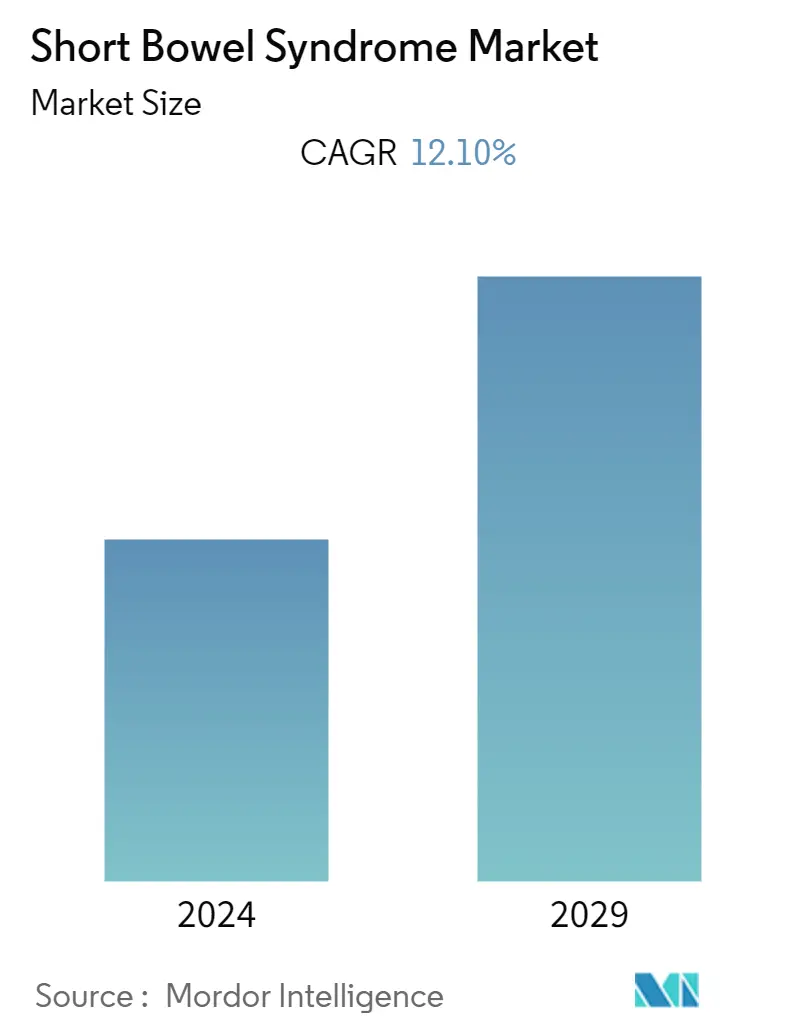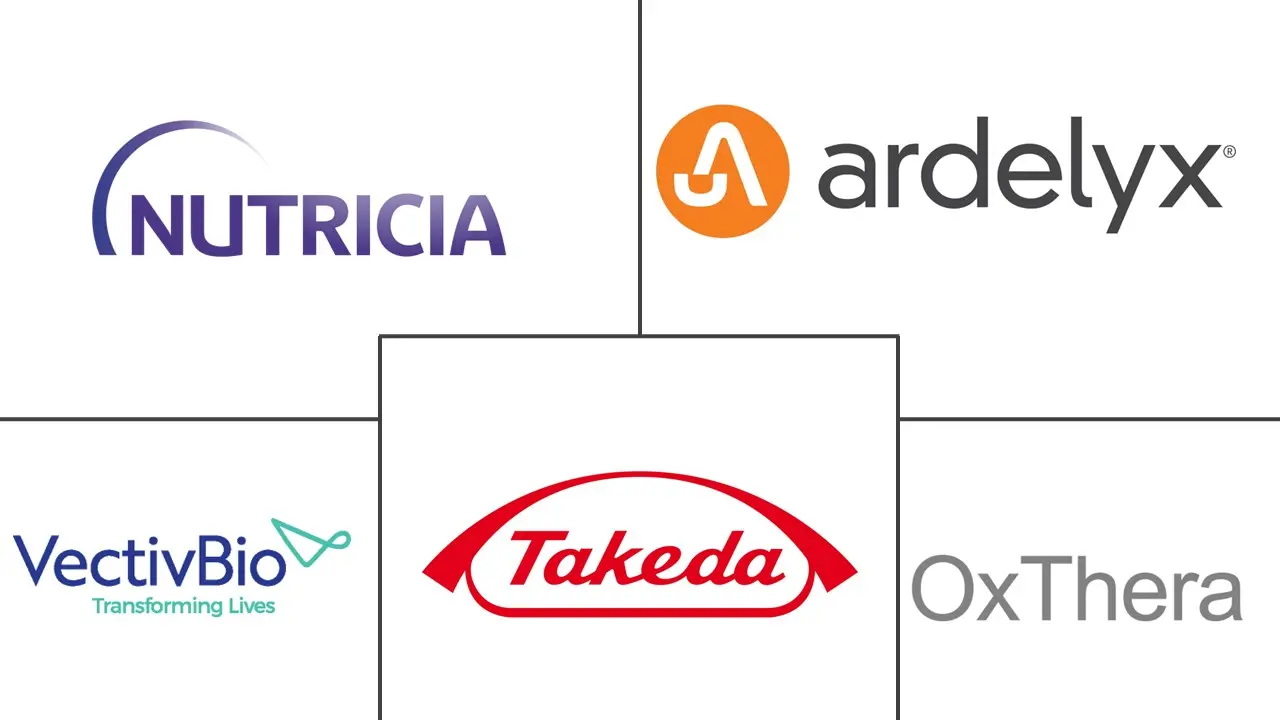Market Size of Short Bowel Syndrome Industry

| Study Period | 2019 - 2029 |
| Base Year For Estimation | 2023 |
| Forecast Data Period | 2024 - 2029 |
| CAGR | 12.10 % |
| Fastest Growing Market | Asia Pacific |
| Largest Market | North America |
Major Players
*Disclaimer: Major Players sorted in no particular order |
Short Bowel Syndrome Market Analysis
The short bowel syndrome (SBS) market is anticipated to grow with a CAGR of 12.1%, during the forecast period.
Covid-19 is expected to impact the short bowel syndrome up to a certain level due to the complexity of the disease. For instance, according to a study published in the Journal of Parenteral and Enteral Nutrition in August 2022, short bowel syndrome (SBS) has been considered a risk factor in Covid-19 patients due to the complexity of the short bowel syndrome disease, the need for interdisciplinary treatment, and the frequency of caregiver contacts. This might have impacted the market growth due to the increased adoption of SBS drugs. During the initial phase of the pandemic, the market has seen a lack of pace due to supply chain restrictions. Furthermore, the market is expected to take until mid of 2023 to reach pre-COVID demand. Until then, the production facilities are expected to recover with a skewed production schedule, which may fluctuate based on demand.
The major factors attributing to the growth of the SBS market are the increased prevalence of GI disorders such as volvulus, Inflammatory bowel disease (IBD), Crohn's disease (CD), and mesenteric ischemia, rising awareness by non-profit organizations, and rising initiatives from the key players in the launch of key products, among others.
According to the study published in Surgery Today in January 2021, SBS is expected to occur in 24.5 out of every 100,000 live births and a comprehensive assessment is necessary before choosing among the available nutritional, medicinal, and surgical therapy. Therefore, the high prevalence of SBS is expected to drive market growth due to the adoption of therapies to combat the syndrome.
Furthermore, the rising initiatives from the market players in the development of therapies for SBS are expected to drive market growth over the forecast period. For instance, in June 2022, 9 Meters Biopharma, a clinical-stage company released positive preliminary topline results from the phase II study of VurolenatIde for SBS. Therefore, the rising research activities by the market players will lead to the development of novel therapies for SBS, thereby leading to increased adoption, and driving market growth.
Therefore, the rising prevalence of GI disorders and increasing launches of therapies for SBS is expected to drive market growth. However, the lack of availability of approved drugs in developing countries and lethal adverse complications like colonic cancer, and polyps along with common side effects associated with the medication are the factors expected to hinder the market growth.
Short Bowel Syndrome Industry Segmentation
As per the scope of the report, short bowel syndrome (SBS) is a metabolic disorder that occurs due to the malfunctioning or removal of the small intestine through surgery due to digestive illness. The consequences may be malabsorption, diarrhea, steatorrhea, fluid and electrolyte disturbances, and malnutrition. The Short Bowel Syndrome Market is Segmented by Drug Class (GLP-2, Growth Hormone, Glutamine, Others), Distribution Channel (Hospital Pharmacies, Retail Pharmacies, Others), and Geography (North America, Europe, Asia-Pacific, Rest of the World). The report offers the value (in USD million) for the above segments
| By Drug Class | |
| GLP-2 | |
| Growth Hormone | |
| Glutamine | |
| Others |
| By Distribution Channel | |
| Hospital Pharmacies | |
| Retail Pharmacies | |
| Others |
| Geography | ||||||||
| ||||||||
| ||||||||
| ||||||||
| Rest of the World |
Short Bowel Syndrome Market Size Summary
The short bowel syndrome (SBS) market is poised for significant growth, driven by the increasing prevalence of gastrointestinal disorders such as Crohn's disease and inflammatory bowel disease, which are key contributors to SBS. The market is experiencing a resurgence post-COVID-19, with a recovery in production facilities and a rise in the adoption of SBS therapies. The development and approval of novel therapies, particularly those involving glucagon-like peptide-2 (GLP-2) drugs, are expected to propel market expansion. These therapies have shown promise in enhancing intestinal rehabilitation and are supported by ongoing research and positive clinical trial results. The market's growth is further bolstered by initiatives from key industry players and non-profit organizations, which are raising awareness and driving the launch of new products.
North America is anticipated to maintain a substantial share of the SBS market, supported by a robust healthcare infrastructure and increased government funding for research on related conditions like Crohn's disease. The region's high prevalence of SBS, coupled with significant grants for inflammatory bowel disease research, is expected to fuel market growth. The competitive landscape is characterized by the presence of prominent players such as TAKEDA Inc, VectivBio AG, and Zealand Pharma, who are actively engaging in partnerships and expanding their global market presence. These dynamics, along with the ongoing development of effective therapies, are set to drive the SBS market forward over the forecast period.
Short Bowel Syndrome Market Size - Table of Contents
-
1. MARKET DYNAMICS
-
1.1 Market Overview
-
1.2 Market Drivers
-
1.2.1 Increased Prevalence of Short Bowel Syndrome and GI disorders such as volvulus, Inflammatory bowel disease (IBD), Crohn's disease (CD) etc.
-
1.2.2 Rising Efforts in the Launch of Effective Treatments and Awareness Programs by Non-Profit Organizations
-
-
1.3 Market Restraints
-
1.3.1 Lack of Availability of the Approved Drugs in Developing Countries
-
1.3.2 Lethal Adverse Complications like Colonic Cancer, Polyps along with Common Side Effects Associated with the Medication
-
-
1.4 Porter's Five Force Analysis
-
1.4.1 Threat of New Entrants
-
1.4.2 Bargaining Power of Buyers/Consumers
-
1.4.3 Bargaining Power of Suppliers
-
1.4.4 Threat of Substitute Products
-
1.4.5 Intensity of Competitive Rivalry
-
-
-
2. MARKET SEGMENTATION (Market Size by Value - USD million)
-
2.1 By Drug Class
-
2.1.1 GLP-2
-
2.1.2 Growth Hormone
-
2.1.3 Glutamine
-
2.1.4 Others
-
-
2.2 By Distribution Channel
-
2.2.1 Hospital Pharmacies
-
2.2.2 Retail Pharmacies
-
2.2.3 Others
-
-
2.3 Geography
-
2.3.1 North America
-
2.3.1.1 United States
-
2.3.1.2 Canada
-
2.3.1.3 Mexico
-
-
2.3.2 Europe
-
2.3.2.1 Germany
-
2.3.2.2 United Kingdom
-
2.3.2.3 France
-
2.3.2.4 Italy
-
2.3.2.5 Spain
-
2.3.2.6 Rest of Europe
-
-
2.3.3 Asia-Pacific
-
2.3.3.1 China
-
2.3.3.2 Japan
-
2.3.3.3 India
-
2.3.3.4 Australia
-
2.3.3.5 South Korea
-
2.3.3.6 Rest of Asia-Pacific
-
-
2.3.4 Rest of the World
-
-
Short Bowel Syndrome Market Size FAQs
What is the current Short Bowel Syndrome Market size?
The Short Bowel Syndrome Market is projected to register a CAGR of 12.10% during the forecast period (2024-2029)
Who are the key players in Short Bowel Syndrome Market?
TAKEDA Inc, OxThera, VectivBio AG, Ardelyx and Nutricia are the major companies operating in the Short Bowel Syndrome Market.

